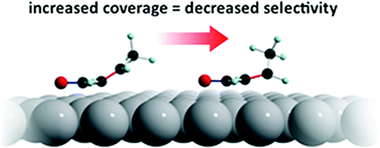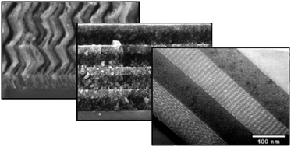Artículos SCI
2012
2012
Nanotecnología en Superficies y Plasma
Adsorption Geometry Determines Catalytic Selectivity in Highly Chemoselective Hydrogenation of Crotonaldehyde on Ag(111)
Brandt, Katrin; Chiu, May E.; Watson, David J.; Tikhov, Mintcho S.; Lambert, Richard M.Journal of Physical Chemistry C, 116 (2012) 4605-4611
Show abstract ▽

The chemoselective hydrogenation of crotonaldehyde to crotyl alcohol was studied by temperature-programmed desorption/reaction, high-resolution XPS, and NEXAFS. The organic molecule adsorbed without decomposition, all three possible hydrogenation products were formed and desorbed, and the clean overall reaction led to no carbon deposition. Selectivities up to 95% were found under TPR conditions. The observed behavior corresponded well with selectivity trends previously reported for Ag/SiO2 catalysts, and the present findings permit a rationalization of the catalytic performance in terms of pronounced coverage-dependent changes in adsorption geometries of the reactant and the products. Thus, at low coverages, the C═O bond in crotonaldehyde lies almost parallel to the metal surface, whereas the C═C was appreciably tilted, favoring hydrogenation of the former and disfavoring hydrogenation of the latter. With increasing coverage of reactants, the C═C bond was forced almost parallel to the surface, rendering it vulnerable to hydrogenation, thus markedly decreasing selectivity toward formation of crotyl alcohol. Butanol formation was the result of an overall two-step process: crotonaldehyde → crotyl alcohol → butanol, further hydrogenation of the desired product crotyl alcohol being promoted at high hydrogen coverage due to the C═C bond in the unsaturated alcohol being driven from a tilted to a flat-lying geometry. Finally, an explanation is offered for the strikingly different behavior of Ag(111) and Cu(111) in the chemoselective hydrogenation of crotonaldehyde in terms of the different degrees of charge transfer from metal to C═O π bond, as suggested by C 1s XPS binding energies.
Enero, 2012 | DOI: 10.1021/jp208831h
Analysis of the restoration of an historical organ: The case study of the Cavaillé-Coll organ of La Merced Church in Burgos, Spain
Justo-Estebaranz, A; Herrera, LK; Duran, A; Siguenza, B; de Haro, MCJ; Laguna, O; Justo, AStudies in Conservation, 57 (2012) 21-28
Show abstract ▽
The restoration of the Cavaille-Coll Romantic organ housed in La Merced Church of Burgos, Spain is described in this paper. The organ was affected by a fire that took place in the church. The effect of the fire on the pipes differed depending on their location within the instrument. A combination of analytical techniques (X-ray diffraction, scanning electron microscopy with energy-dispersive X-ray analysis, particle-induced X-ray emission, metallography, and specific density) allowed the accurate determination of the microstructures and compositions of the alloys used to make the different pipes of the organ, some of which had a high tin content and others which had a high lead content. The most damaged pipes were replaced by reconstructed pipes made out of metallic sheets of the same composition as the originals, to ensure a historically accurate sound.
Enero, 2012 | DOI: 10.1179/2047058411Y.0000000001
Degradation of Two Historic Buildings in Northern Spain by Formation of Oxalate and Sulphate-Based Compounds
Duran, A; Robador, MD; Perez-Rodriguez, JLInternational Journal of Architectural Heritage, 6 (2012) 342-358
Show abstract ▽
This study focused on the degradation processes for two historic buildings, one in a rural and one in an urban environment. Samples collected from the Romanesque Church of Torme and from two areas of the Cathedral of Burgos were studied by using optical and electron microscopy, x-ray spectrometry, x-ray diffraction, Fourier transform infrared spectroscopy and thermal analysis (TG/DTA/DTG). As result of the action of microorganisms, weddellite and whewellite were found to have formed over the entire external walls of the Church of Torme, built with dolomitic rock. Gypsum, formed by the effects of atmospheric pollution, appeared on lime plasters applied as protective coatings on the external stones of Burgos' Cathedral. Also discussed in this study is the different composition of these plasters, based on the use of calcareous and siliceous aggregates.
Enero, 2012 | DOI: 10.1080/15583058.2010.551447
Nanotecnología en Superficies y Plasma
Superhydrophobic supported Ag-NPs@ZnO-nanorods with photoactivity in the visible range
Macias-Montero, M; Borras, A; Saghi, Z; Romero-Gomez, P; Sanchez-Valencia, JR; Gonzalez, JC; Barranco, A; Midgley, P; Cotrino, J; Gonzalez-Elipe, ARJournal of Materials Chemistry, 22 (2012) 1341-1346
Show abstract ▽

In this article we present a new type of 1D nanostructures consisting of supported hollow ZnO nanorods (NRs) decorated with Ag nanoparticles (NPs). The 3D reconstruction by high-angle annular dark field scanning transmission electron microscopy (HAADF-STEM) electron tomography reveals that the Ag NPs are distributed along the hollow interior of the ZnO NRs. Supported and vertically aligned Ag-NPs@ZnO-NRs grow at low temperature (135 °C) by plasma enhanced chemical vapour deposition on heterostructured substrates fabricated by sputtered deposition of silver on flat surfaces of Si wafers, quartz slides or ITO. The growth mechanisms of these structures and their wetting behavior before and after visible light irradiation are critically discussed. The as prepared surfaces are superhydrophobic with water contact angles higher than 150°. These surfaces turn into superhydrophilic with water contact angles lower than 10° after prolonged irradiation under both visible and UV light. The evolution rate of the wetting angle and its dependence on the light characteristics are related to the nanostructure and the presence of silver embedded within the ZnO NRs.
Enero, 2012 | DOI: 10.1039/C1JM13512K
2011
2011
Materiales Ópticos Multifuncionales
Porous one dimensional photonic crystals: novel multifunctional materials for environmental and energy applications
Mauricio E. Calvo, Silvia Colodrero, Nuria Hidalgo, Gabriel Lozano, Carmen López-López, Olalla Sánchez-Sobrado and Hernán MíguezEnergy and Environmental Science, 4 (2011) 4800-4812
Show abstract ▽

In recent times, several synthetic pathways have been developed to create multilayered materials of diverse composition that combine accessible porosity and optical properties of structural origin, i.e., not related to absorption. These materials possess a refractive index that varies periodically along one direction, which gives rise to optical diffraction effects characteristic of Bragg stacks or one-dimensional photonic crystals (1DPCs). The technological potential of such porous optical materials has been demonstrated in various fields related to energy and environmental sciences, such as detection and recognition of targeted biological or chemical species, photovoltaics, or radiation shielding. In all cases, improved performance is achieved as a result of the added functionality porosity brings. In this review, a unified picture of this emerging field is provided.
Diciembre, 2011 | DOI: 10.1039/C1EE02081A
- ‹ anterior
- 343 of 422
- siguiente ›














